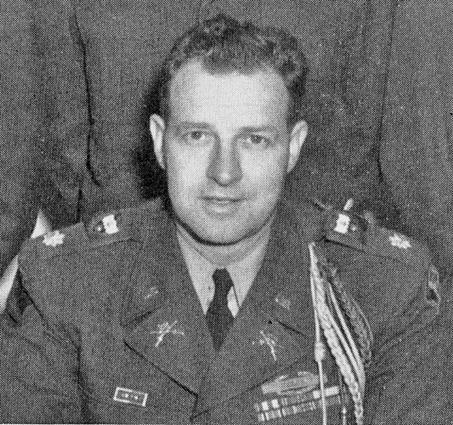

Major Sam Carter
Commanding Officer 1st Battalion 22nd Infantry
4th Infantry Division
1951-1952
Sam Carter was born in Alabama on July 20, 1913.
He was commissioned a 2nd
Lieutenant in the Infantry Reserves on June 5, 1939
and entered Active Duty on July 5, 1939.
Carter received a Bachelor of Science degree from Syracuse University in 1940.
He was promoted to the temporary rank of 1st Lieutenant (AUS) on February 18, 1941.
He was promoted to the temporary rank of Captain (AUS) on February 11, 1942.
He was promoted to the temporary rank of Major (AUS) on July 26, 1944.
During World War II he received the Silver Star Medal and the Bronze Star Medal w/Oak Leaf Cluster.
With the reduction of the Army
after the war Carter was offered a commission in the Regular Army
as a 1st Lieutenant of Infantry on August 24, 1946, with date of
rank back to July 20, 1941.
He accepted the commission on August 27, 1946.
He was a graduate of the
Infantry School Advanced Officer Course in 1948 and was promoted
to the
permanent rank of Captain in the Regular Army on July 15, 1948.
He was promoted to the permanent rank of Major in the Regular Army on May 15, 1950.
He was promoted to the temporary rank of Lieutenant Colonel (AUS) on June 26, 1953.
Carter was promoted to the permanent rank of Lieutenant Colonel in the Regular Army on November 26, 1956.
Sam Carter retired from the Army with the rank of Lieutenant Colonel on December 31, 1964.
**********************
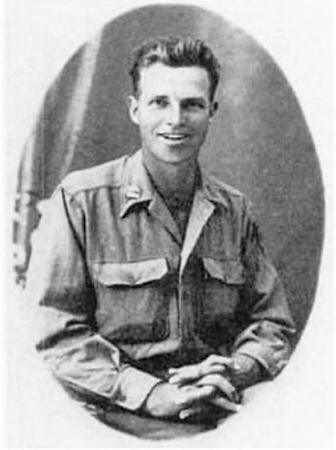
Captain Sam Carter 18th Infantry 1943
Sam Carter is originally from
Alabama and was a 1st Lieutenant in Company D when the 18th
Infantry Regiment
of the 1st Infantry Division was conducting training exercises at
Fort Devens Massachusetts in 1940. By the time
Pearl Harbor was bombed, he had become the commanding officer of
the company and had received a promotion to Captain.
Carter remained in command of Company D, which was comprised of
two machine gun platoons and an 82mm mortar platoon,
through the fighting in North Africa and Sicily. In Europe, he
landed with the company in the early afternoon of D-Day in
Normandy
and remained in command until reaching Caumont.
In July 1944, Carter was
promoted to Major and transferred to the 18th Infantry Regiment's
3rd Battalion where he became
its Executive Officer. He served in this capacity until early
1945 and was then assigned to the regimental staff where he
became
the Regiment's Intelligence Officer (S-2), a duty assignment he
remained in until the war ended.
Sam Carter retired from the
United States Army following the war as a Lieutenant-Colonel. He
and his wife Norma
have been married for over 60 years and live happily and
independently at their home in Bradenton, Florida.
Sam's experiences of his time in
North-West Europe with 1st Infantry Division were transcribed
from his taped recollections.
The transcript is on file with the 1st Division Cantigny Research
Center, Wheaton, Illinois. Much related material can be found
in the book American Iliad: The 18th Infantry Regiment in
WWII by Bob Baumer, published by the Aberjona Press (ISBN
0-9717650-5-7).
From On the Bloody
Road to Berlin: Frontline Accounts from North-West Europe and the
Eastern Front 1944-45
Edited by Duncan Rogers and Sarah Williams, Helion & Company
Limited, 2005 ISBN 1874622086, 9781874622086
Veterans recall courage, carnage of D-Day
By Melanie Marquez | 1st
Infantry Division | May 04, 2007
BRADENTON, Florida - Retired Lt. Col. Sam Carter wants people to
remember that D-Day, the day American, British and
Canadian forces stormed a northern beach of France, was more than
just a day.
Thin and weak from two other
invasions and months of fighting, Carter arrived in England with
his fellow men of the Army's
18th Infantry 1st Division in October of the previous year. His
unit stayed there training, gaining strength and building forces
until the right day - June 6, 1944 - when the right tide would
take them to the sandy, mine-ridden shore of Omaha Beach,
where more than 2,000 U.S. soldiers would die.
"It was more than just a day," Carter said.
Following the invasion, he and his men worked for more than 13 hours to walk 13 miles inland from the shore.
"Day and night, you don't know the difference," he said, recalling the journey. "You just fight."
His wife, Norma, expects they
will hear from friends today, the 62nd anniversary of D-Day. They
usually call to honor an event
that still lives vividly in her husband's mind. A memory that he
says would take years to fully talk about.
Carter turns 93 this summer. He
turns down help when he gets up to walk and sometimes hands off
his cane to walk without it.
His 443 days in combat kept him from meeting one of his daughters
until she was more than 2 years old.
In his pocket Carter carries a
brown rock he picked up on the French shoreline in the 1950s, a
rock he couldn't have picked up
the day of the invasion, when he worked his way up the beach
seeing friends die as he trudged along.
"You didn't have time to
stop," Carter said. "People can't understand these
things, but you don't have time to stop
and bless everyone and talk with them."
He has contributed to two books,
"American Iliad" and "On the Bloody Road to
Berlin." In the former, Carter is quoted saying,
"World War II is so impressed in my brain, my heart, my
body, and my soul that it will not end until the day I die."
Carter has lived for 41 years in
the eastern part of Bradenton, the area known as Old Manatee, in
a home not far from
the Manatee River with his wife of more than 66 years.
A photo of his days at the
Pentagon rests against the wall near the kitchen. A gold statue
of a soldier stepping onto a rock
and reaching his hand in the air sits on the second shelf of a
bookcase near the door, a statue he earned after retiring.
Carter was known as "Silent Sam" when he was in the Army, his wife said with a smile, "But he's making up for that now."
From the Fort Riley, Kansas website
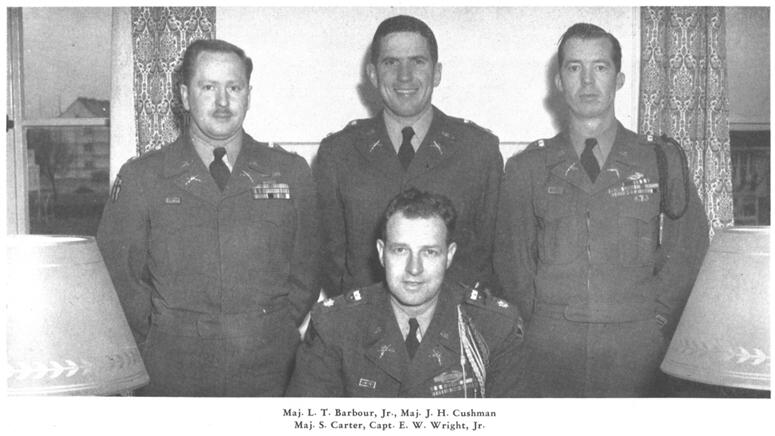
Major Sam Carter (seated, foreground)
as Battalion Commander 1st Battalion 22nd Infantry with his staff
in Germany 1951-1952.
Standing directly behind Carter is his S-3 Officer Major John H.
Cushman.
Photo from the 4th Infantry Division European Command 1951-52 yearbook
The exact dates of Carter's
command of 1st Battalion 22nd Infantry are unknown at this time.
He was most certainly
in command of 1st Battalion during the 1951-1952 time frame while
the Battalion was stationed in Germany.
Retired Lieutenant General John
H. Cushman served under Carter as the S-3 Operations Officer for
1st Battalion 22nd Infantry
in Germany. The following passages from an interview Cushman gave
for the Center of Military History illustrate
the kind of Commander Carter was with 1st Battalion 22nd
Infantry.
On Sam Carter:
GEN CUSHMAN: ...The 1st
Battalion was commanded by Major Sam Carter, a crusty old
infantry officer who had served in
the 18th Infantry, 1st Infantry Division, throughout World War
Two. He had been a weapons company commander and he was
really experienced. He was frank with his opinions and that was
probably why he had been passed over for lieutenant colonel.
He couldn’t have been a better mentor for me assigned as the
S3 of the 1st Battalion.
GEN CUSHMAN: I was learning from
Sam Carter. I remember one time I wanted to train the companies
to conduct a night attack.
I wrote the exercise according to the Fort Benning way. I had
picked a piece of ground to train on and I planned it exactly the
way
that Fort Benning said. I established a line of departure and was
about to order the company to get to there at night and attack
the hilltop. I took Sam Carter out and I said, “This is the
problem I’m going to set up for the company night
attack.” He said,
“That’s no good. That’s not the way you make a
night attack. In the war these lieutenants would come to us in
the 18th Infantry
from Fort Benning and we’d have to train them all over
again. I don’t know how many of these lieutenants we had to
straighten out
before they got killed. That’s not the way to make a night
attack. The way to make a night attack is you go up to the enemy
line,
and you put them through single file, and you get behind the
enemy, set up a position in their rear and then surprise them the
next morning.
That’s the way you make a night attack.”
From Sam Carter I learned how to
do a night attack and by experience I learned about teaching. He
taught me how to handle
machine guns. We had a machine gun platoon, a 75mm recoilless
rifle platoon, and an 81mm mortar platoon in our
weapons company. Each company had three platoons plus a weapons
platoon with machine guns and 60mm mortars.
It was a simple and straightforward organization, easy to manage.
He had ideas on how things should be done.
He took a liking to me. When I saw his efficiency reports later
they showed that he thought highly of me.
Sam Carter once taught me how he
proposed to defend against Soviet tanks. Our regiment had two
truck companies attached,
enough to put the whole regiment on wheels. It had three infantry
battalions, a tank company, a heavy mortar company, a service
company and a headquarters company. We were going to be fighting
large Soviet tank units. How can you stop tanks
with infantry mounted on trucks? Sam Carter said that these tanks
were going to move down the roads and would eventually
move through the towns. He wanted to create anti-tank ambushes
from the houses in and around these towns. He figured
that the way to do it is create tank-killer teams armed with
machine guns and recoilless rifles and position them at choke
points
in the town. We’d set up a line of mines off to the side of
the road and then pull them across, in front of the advancing
tanks,
stop them and shoot them up.
He said to me, “I want you
to set up a demonstration.” He wanted to get the whole
battalion out there and show them how
to do this. So I found a little town near a small hillside with a
view into the town. We put the soldiers of the battalion up there
so
they could observe the whole event. I had a demonstration platoon
set up a defense in the town. We put up loud speakers
and I was doing the instruction. I said, “Now here’s
how this is done.” I had a tank from our tank company roll
through
and the demonstration platoon pulled the mines across the road
and simulated ambushing the tank column.
It was a good demonstration.
On training:
GEN CUSHMAN: ...Field Service
Regulation Operations, FM 100-5, 1949, taught how to run the
whole thing. I loved that manual.
That manual was my bible. I used to read it at night. In the
field I would have that manual with me. It was so clear. It was
just
sentences, small paragraphs, not chapters, and it wasn’t
like bullet points, but just paragraph after paragraph,
short paragraphs of good, solid wisdom.
INTERVIEWER: How does that balance with your experience with Major Carter?
GEN CUSHMAN: It was consistent.
I found Major Carter was a good tactician. He could look at the
contours on a 1:100,000 map
and say, “That’s a good place for a machine gun
position.” He had a sense for ground that was remarkable.
INTERVIEWER: What was his opinion of infantry doctrine?
GEN CUSHMAN: He thought the
doctrine as written was all right but you had to use common sense
in application such as
when you are organizing a defensive position with machine guns
and strong points. The doctrine didn’t tell you how to do it
on a much larger front than the field manuals were written for.
You have to figure that out for yourself.
Carter taught me how to adapt.
INTERVIEWER: That’s
interesting. One of the things I have found interesting about you
is your approach to doctrine.
You believe that doctrine should make you think. Did you get that
from Carter?
GEN CUSHMAN: I’ve been
thinking that my whole life. I’m a believer in thinking. At
the officer level we should teach you
both how to fight and how to think. Now at the squad level you
have to have battle drill but inside that framework you still
think.
I believe in structure, thinking inside the structure.
INTERVIEWER: Was that Sam Carter’s approach too?
GEN CUSHMAN: He wasn’t a revolutionary. He didn’t want to reorganize the Army. He just adapted to the situation.
INTERVIEWER: The adaptation of
the tank-killer team is an example of that. It seemed like you
were task organizing squads
around effective weapon systems.
GEN CUSHMAN: The regiment had a
sector of the front line with a cavalry screen in front of us. My
battalion expected
to meet the Russians near a town called Alsfeld. It was a broad
front but the book didn’t say how to organize ground like
that.
Doctrine called for a smaller front. It is fine to draw little
circles and dots on a map but when you have a large front and
the enemy is coming at you with this big outfit and all you have
is a battalion on foot and in trucks, you have to adapt.
We task organized around choke points and that’s the way
we’d fight.
On the kind of experience Carter possessed and was able to impart to his officers:
GEN CUSHMAN: Sam Carter had
taught me a trick on putting in a defense position. You give
every soldier a quarter-pound
block of TNT and a blasting cap with a fuse on it. You make sure
they each put the TNT in one pocket and the blasting cap
in another. When you get to the position and you select the
location of your fox hole, you dig a hole about 8 inches deep
for the TNT. You fuse the TNT and you tamp it and light it with a
match and you go back and wait for it to explode.
That makes it really easy to dig out the crater and you can
really get a fox hole dug very quickly. So I trained my soldiers
to do that. Their fox holes were terrific. We got high grades on
that.
From the Oral History Project by historian Robert Mages of the US Army Military History Institute at Carlisle Barracks, PA. 2009
From West-Point.Org
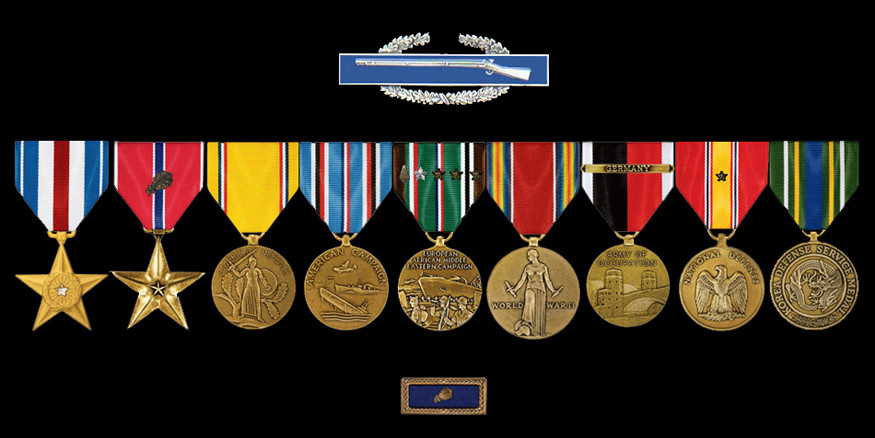
LTC Sam Carter's decorations
He was also awarded the French
Fourragere and Belgian Fourragere. He can be seen wearing both
Fourrageres
around his left shoulder in the photo at the top of this page.
Saturday 9 December 2006:
Lieutenant Colonel Col. Sam
Carter, a retired Army man known for his more than 26 years of
military service
that spanned almost all of World War II, including D-Day, died
Wednesday. He was 93.
"He answered his last roll call," said Norma Carter,
his wife of more than 66 years.
The couple met at Syracuse University, where Colonel Carter was
in the ROTC.
"He was such a handsome young man," Mrs. Carter said
Friday afternoon.
The couple graduated in June 1939 and married in October of 1940.
Two years later, Colonel Carter was sent to war, seeing 443 days
of combat over 35 months.
He served as a commanding officer for D Company, 1st Battalion,
18th Infantry, 1st Infantry Division.
After the war he served on the Clemency Board at the Pentagon
reviewing 33,000 court martial cases
held during the war in Europe.
Colonel Carter was proud of his service and spoke about it
vividly. The couple's Old Manatee home
is decorated with photographs and plaques commemorating his
service. He stayed active in his retirement
with the First Division Society and served as president of the
East Bradenton Civic Association.
"He's always been direct and outspoken," his wife said.
"He was open-minded and determined."
Colonel Carter volunteered with the Manatee Village Historical
Park and lived in Bradenton for 41 years,
in a house not far from the Manatee River. The couple's move to
Bradenton was then their 29th move
in 24 years of marriage.
Robert Pelot, of Pelot's Pharmacy, met Carter through Manatee
United Methodist Church.
"There's a lot of respect for Mr. Carter," Pelot said.
"I appreciate him for his service."
A memorial service is scheduled for 2 p.m. Wednesday at the
Manatee Village Historical Park.
Interment, with full military honors, is scheduled for 1 p.m.
February 5, 2007, at Arlington National Cemetery.
In lieu of flowers, donations may be made to the 1st Division
Scholarship Fund
(for children of service personnel in the division), at 1933
Morris Road, Blue Bell, Pennsylvania 19422.
Posted: 9 December 2006
From the Arlington National Cemetery Website
Birth: Jul. 20, 1913
Death: Dec. 6, 2006
Obituary:
Lt. Col. Sam Carter, U.S.A.R., answered his last roll call Dec.
6, 2006, and entered into the spiritual joy
of the Lord. Sam Carter, son of Arthur Lawrence and Sarah
Chambers Carter, was born July 20, 1913, in Opp,
Ala. He attended local schools and graduated from Opp High
School. Following the death of his father, Sam,
his mother, brother, and sister moved to New York City where his
mother worked in the diet kitchen at
Presbyterian Hospital. Life-long Methodists, the family became
active in Broadway Temple. Sam went to work
for Kraft, in the New Jersey plant, making Miracle Whip. When he
had saved $200, and with a scholarship from
the church, Sam enrolled at Syracuse University. He became active
in the crew (as stroke) and R.O.T.C. Sam
waited on tables for his board. His future wife, Norma Richards,
also waited on tables. Following graduation
in June 1939, Sam went on active duty at Fort Hamilton, N.Y., as
a 2nd Lieutenant in D Company, 1st
Battalion, 18th Infantry, 1st Infantry Division. Sam married
Norma Richards at Calvary Baptist Church, in
Providence, R.I., on Oct. 26, 1940, and then lived at Fort
Hamilton until the Division moved to Fort Devens,
Mass., in 1941. When the United States entered World War II on
Dec. 7, 1941, Sam became the Commanding
Officer of Company D commanded through Africa, Sicily, and
Normandy, until reaching Caumont, France. He
became a Regimental Intelligence Officer (S2), an assignment he
remained in until the end of the war. With
the 1st Division, Sam had 443 days of combat over 35 months,
receiving many awards and citations for his
service. Following the war he served on the Clemency Board at the
Pentagon reviewing 33,000 court martial
cases held during the war in Europe. He and the family later
returned to Germany on assignment with the 4th
Division commanding the 1st Battalion of the 22nd Regiment. He
spent 15 months in Korea and his final
assignment was at Ft. George G. Meade, Maryland, retiring to
their home in Bradenton, Fla., after 26-1/2
years of service. In retirement, Sam was active in the First
Division Society, with he and his wife attending
reunions and working on committees. His experiences of his time
in North West Europe with the 1st Division
have been transcribed from his taped recollections and are on
file in the 1st Division Cantigny Research
Center in Wheaton, Ill. He has contributed to three books on
W.W.II, including ''The Bloody Road to Berlin''
published in England. Sam has been active in civic affairs, was
President of East Bradenton Civic
Association. At present, he was President Pro-tem of the Florida
Chapter of the 1st Division Society. He was
also a member of the H.O.M.E. Committee from its inception at the
Historic Park. He is survived by his
beloved wife of 66 years, Norma; a son, John, of Bradenton; two
daughters, Alice Carter Lawton, of Tampa,
Fla., Jana Sue Carter, Spokane, Wash.; a cousin, Peggy Nelson, of
Bradenton; a grandson, Sam (Carla) Lawton,
of Land O' Lakes, Fla.; a granddaughter, Susan Lawton (Shane)
Weeks, of Acworth, Ga.; great-grandsons, Corey
Gene Lawton, of Land 'O Lakes, Fla.; Chandler Weeks, of Acworth,
Ga. He was predeceased by his two daughters,
Mary Ellen Carter and Sara Kay Carter. A memorial service will be
held at the Manatee County Historic Park at
2p.m., Wednesday, Dec. 13. Interment will be held Feb. 5, 2007,
at 1p.m., at Arlington National Cemetery,
with full military honors.
Published in The Herald on 12/10/2006.
From the Find A Grave website
Sam Carter is buried in Arlington National Cemetery
Section 10 Grave 10782-B
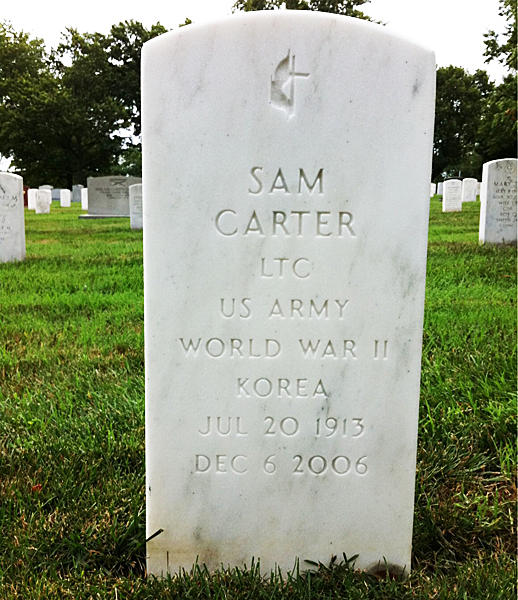
Grave marker for Sam Carter
Photo from the Arlington National Cemetery website
Top photo of Major Sam Carter as Commander 1st
Battalion 22nd Infantry
from the 4th Infantry Division European Command 1951-52 yearbook
Home | Photos | Battles & History | Current |
Rosters & Reports | Medal of Honor | Killed
in Action |
Personnel Locator | Commanders | Station
List | Campaigns |
Honors | Insignia & Memorabilia | 4-42
Artillery | Taps |
What's New | Editorial | Links |